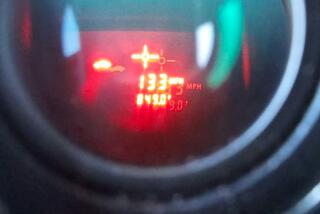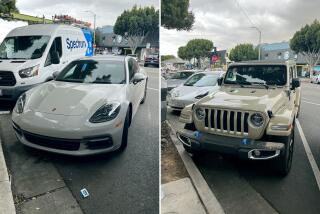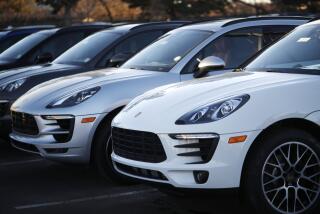Ah, Porsche: Good News, Bad News
- Share via
To examine Porsche these days is to sense the sadness that comes with witnessing the mortality and descent of any oligarchy.
The company continues to make sovereign sports cars: pedigreed, blueblooded and indestructible machines. A Porsche is still built to behave very quickly as a single system. Porsches show no slack, no noticeable transitions between the functions of braking, steering, accelerating and flattening a chassis against a road. They are among the best.
Yet Porsche sales are face down in the mud.
Last year, the company sold a piddling 15,737 cars in the United States, a horrible 50% drop from its boom year of 1986.
The first half of this year is starting to look like the last half of the Lakers’ championship finals. Porsche had sold only 3,600 vehicles by June 1, and at this pace, all public relations positivism to one side, 1989 could be Stuttgart-Zuffenhausen’s first serious sight of Armageddon.
The rock: Sharp depreciation of the U.S. dollar against the Deutschmark has pushed Porsche’s prices way above the competition and maybe even beyond the value the car once represented.
The hard place: The Japanese--and in some cases American manufacturers--have been marketing cars with Porsche’s performance numbers but at half the sticker prices.
The final nail: Even Porsche’s devout began buying elsewhere rather than investing in styling that to naked eyes and image shoppers really hasn’t changed in more than two decades.
“January and February were almost frightening,” a spokesman for Reno-based Porsche Cars North America said. “We also recognize that (this year) we are not going to be selling 30,000 or even 17,000 vehicles . . . but it (the current sales situation) is not something that is going to put the company out of business.
“I don’t want to appear sanguine about it, but there are some bright spots.” He said sales of the everlasting Porsche 911 with a silhouette that hasn’t budged much since 1964, have started shifting upward. The entry-level 944 seems to be holding its own. “They’re still not good figures but there does seem to be some life in the sports car market. We are doing things and hopefully there will be some results.”
What Porsche AG of West Germany is doing may best be seen as biting the bullet while swallowing most of the gunpowder.
It has cut its West German work force. Next, it reduced and rearranged production of its 12-vehicle line. Porsche then executed the un-American and inconceivable--it actually reduced prices on some models and by as much as $3,000.
Sadly, throughout this corporate depression, Porsche hasn’t introduced any really new cars because no company dedicated to quality and craftsmanship can move that fast in any pinch.
Memories on Wheels
So the Porsche Carrera 4 is a 911 with all-wheel drive. There’s a soft, rounded-off Speedster geared to memories of the ‘50s and ‘60s but only 400 will be made. Porsche has improved this car, refreshed that one, added a cabriolet here and a turbocharged version there.
Even the “new” Porsche 944S2 is simply a reinforcement of an existing series--a bored-out version of last year’s 16-valve 944S and a tacit admission that the earlier car just wasn’t as tractable, nor as salable, as had been anticipated.
Whether the 944S2 will be a stronger seller, given the current climate, remains moot. Clear, however, is the S2’s improvement over its ancestors--with that added endowment of a $3,000 price reduction.
Redesigning the block, enlarging the cylinder bore and increasing the stroke gives the car 3.0 liters of displacement and 208 horsepower compared with the 2.5 liters and 150 horsepower of last year’s stock 944. This, Porsche says, makes it the most powerful, conventionally aspirated four-cylinder engine in the world.
$15,000 Worth of Extras
The S2 arrives with a checker’s tape of standard equipment that, if it could be declined as options, might knock $15,000 off the sticker. The list includes alloy wheels, heated rear windows and mirrors, anti-lock brakes, driver and passenger air bags, sun roof, Blaupunkt radio, cruise control, power windows and steering, central locking, electrically adjusted mirrors . . . und aller dieser Jazz.
On the road, the S2 is a free-revving, feisty prowler working fully to the standards that are a norm for Porsche, yet seem to be an impossibility for other manufacturers. The car is nimble in first with second gear hooked to an afterburner that’s good to about 60 m.p.h. On the freeway, one can play around all day with third and fourth because the range there is from 60 to 125 m.p.h. In about 15 seconds.
But it’s the breadth and balance of the five-speed box, a feeling of always being in a gear appropriate to the pace, no matter our medium transgressions, that sets Porsche head and shoulders above the competition--if below eye level in sales.
Or is handling the superlative of a Porsche?
In truth, the Porsche probably corners no flatter, no faster than other entrants in its 150 m.p.h. performance class. The steering reads no more, no less, and the suspension seems no stiffer, no softer. But the car feels infinitely superior and from that comes the blessing of increased driver confidence.
Feeling of Safety
Or as automotive photojournalist John Lamm once noted: He feels safer at 170 m.p.h. in the Porsche 959 than he does at 55 m.p.h. in a Chevrolet Nova.
It is a security created by much more than a motor and double overhead this and semi-trailing that. It has to do with establishing a driver’s center of bottom closer to the gravel. And building expensive seats to hold him--or her--there. It’s a matter of balancing a chassis. And chintzing on no unseen suspension attachment to maintain that symmetry.
Then Porsche assembles this total driving system as though its own CEO’s life, limb and comfort depend upon it.
Our test car was a relative old-timer with almost 6,000 miles on it. By IMJ (International Motoring Journalist) standards, that’s a thrashing roughly equivalent to eight Paris-Dakar rallies. That would explain a broken lock on a console box, a hatchback catch that often didn’t and glitchy door locks.
We were never comfortable with the rear-window hydraulics when they are fully extended. They raise the hatchback almost beyond the reach of smaller folk. They certainly were stiff enough to make closing the lid an exercise in leverage roughly the equivalent of humping a 40-pound bag of Kibbles ‘n Bits from a high shelf.
Why Those Back Seats?
And when will Porsche and Nissan and all the 2+2 designers find courage enough to dump those upholstered pie plates posing as rear seats?
They certainly aren’t large enough for adults. Few owners of two children purchase Porsches, and single people rarely ferry neighborhood kids to preschool. So better to lose the seats and return the room to trunk space, which is something all sports cars can use.
The subtle bother about the 944S2, however, is the surprising, but full-blown sense of boredom that comes with the car. In 800 miles, not one head turned and not even brighter youngsters saw this new Porsche as anything but an older Porsche.
It is a car that will last.
It is a car with a painless depreciation rate.
It also is a car offering an odd formula--1989 performance from a 1979 shape. But at a 1999 price.
1989 Porsche 944 S2 COST: Base $41,900. As Tested $43, 827. ENGINE: Four cylinders, 3.0 liters, 16 valves developing 208 horsepower. PERFORMANCE: 0-60, as tested, 6.8 seconds. Top speed, as reported by Road & Track magazine, 149 m.p.h. Fuel economy, average city-highway 19.7 m.p.g. CURB WEIGHT: 2,930 pounds. THE GOOD: Porsche perfection through total packaging of pace, stability and handling. Durability that can be measured in decades. Minimal depreciation. THE BAD: The price. 2 + 2 seating that’s more 2 + 1/2. Rear deck hydraulics for arm wrestlers. Design as daring as a Brooks Bros. suit. THE UGLY: How do you feel about Brooks Bros. suits?






